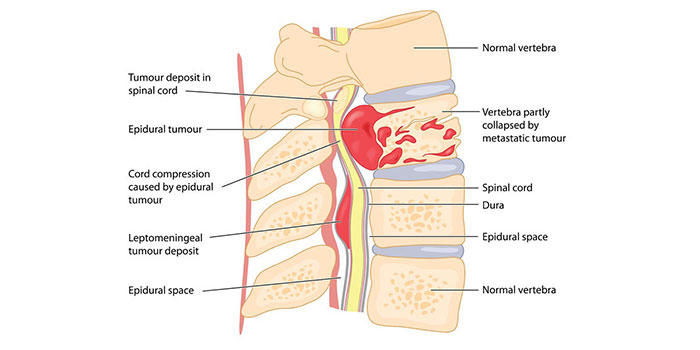Back Pain
A spinal tumor is a growth of cells (or mass) in or surrounding the spinal cord. Tumors in the spinal column may cause back pain from expansion of the bone or from weakening of the bone, which in turn can result in spinal fractures, compression (pinching) of the nerves or spinal instability
Symptoms
The symptoms depend on the location, type of tumor and the patient's general health. Tumors that have spread to the spine from another site often progress quickly. Primary tumors often progress slowly over weeks to years.
Tumors in the spinal cord usually cause symptoms, sometimes over large portions of the body. Tumors outside the spinal cord may grow for a long time before causing nerve damage.
Symptoms may include:
- Abnormal sensations or loss of sensation, especially in the legs (may be in the knee or ankle, with or without shooting pain down the leg)
- Back pain that gets worse over time, is often in the middle or lower back, is usually severe and not relieved by pain medicine, gets worse when lying down or straining (such as during a cough or sneeze), and may extend to the hips or legs
- Cold sensation of the legs, cool fingers or hands, or coolness of other areas
- Fecal incontinence
- Inability to keep from leaking urine (urinary incontinence)
- Muscle contractions, twitches or spasms (fasciculations)
- Muscle function loss
- Muscle weakness in the legs that causes falls, makes walking difficult and may get worse
Metastatic tumors usually produce pain that does not get better with rest, may be worse at night and is often accompanied by other signs of serious illness (such as weight loss, fever, chills, shakes, nausea or vomiting).
Diagnosis
If any tumor is found in the spine and there is no other known cancer, a complete examination of all common organs where cancer develops is usually warranted. Evaluation may include:
- Medical history
- Physical examination
- Neurological examination
- Radiographic studies of the spine, chest and GI system to screen for tumors
- MRI and CT scans to examine the spine
- Cerebrospinal fluid examination
- Cytology (cell studies) of cerebrospinal fluid
Treatment
The goal of treatment is to reduce or prevent nerve damage caused by pressure on the spinal cord.
Treatment should be given quickly. The more quickly symptoms develop, the sooner treatment is needed to prevent permanent injury. Any new or unexplained back pain in a patient with cancer should be thoroughly investigated.
Treatments include:
- Corticosteroids (dexamethasone) — May be given to reduce inflammation and swelling around the spinal cord.
- Emergency surgery — May be needed to relieve compression on the spinal cord. Some tumors can be completely removed. In other cases, part of the tumor may be removed to relieve pressure on the spinal cord.
- Radiation therapy — May be used with, or instead of, surgery.
- Chemotherapy — Has not been proven effective against most spinal tumors, but may be recommended in some cases, depending on the type of tumor.
- Physical therapy — May be needed to improve muscle strength and the ability to function independently.
